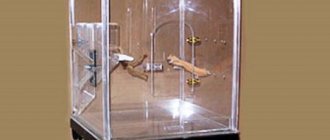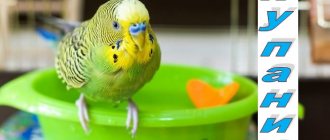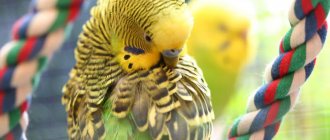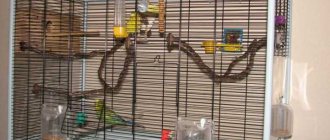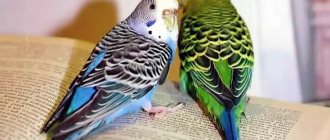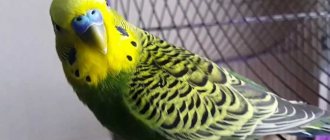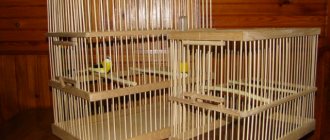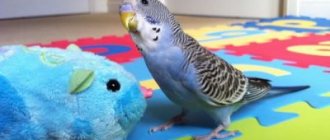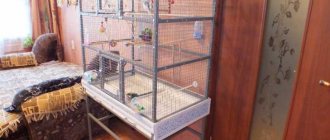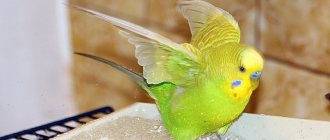Budgerigar Cage Size
The next important condition is the house itself for the budgerigar - its cage, namely its size and arrangement.
In order for the bird to feel comfortable in its home and not feel enclosed, the cage must be of sufficient size. The optimal size is considered to be such that the parrot, sitting on a perch in the middle of its house, can freely spread its wings to the sides and fly a little without feeling discomfort. If the size of the home turns out to be too small for the wavy, then it will behave aggressively, trying in every possible way to leave it.
The length of the house should allow it to be equipped with at least two wooden perches (not plastic ones, as they can lead to the formation of various wounds on the bird’s legs, some kind of calluses, etc.). The width of the cage should allow it to accommodate 2-3 feeders, a drinking bowl, a mineral stone, etc.
The following are considered the optimal cage sizes for budgies:
- For one parrot, its length should be at least 40 cm, width 25 cm, height 30 cm.
- For a pair of budgerigars, the length of the cage should be 60 centimeters, width 30 cm, and height 40 cm.
- For 4 budgerigars or more, the size of the house should be doubled, have at least two exits and two feeders than for one pair.
Mineral feeding
Liquid vitamin and mineral supplements carry a risk of overdose, so they are usually prescribed by an ornithologist - for emergency assistance or for a short period of up to a month. The main feeding is usually sepia or a mineral mixture, which is available in the form of compressed stone or organic sand.
Sepia, or cuttlefish shell, is the best and most easily digestible source of calcium for budgies. The content of this valuable element in it exceeds 37%. In addition, it does not have the main disadvantages of raw eggshells - it does not require additional processing and cannot be contaminated with salmonellosis. But be careful: the cuttlefish bone should not be salted or painted in bright colors. Its natural color is white or ivory. Sepia is easily attached to the bars of the cage and has no contraindications for use, and also helps the bird to grind down its beak. Some parrots need to be trained to eat it, but most will happily nibble it themselves. The sepia is quite soft and the wavy handles it easily. And the content of phosphorus, sodium and magnesium makes it a very valuable supplement. Moreover, sepia is actually the only mineral supplement allowed when feeding chicks. But it is not recommended to grind it and sprinkle it on wet food - firstly, it reacts with fruit juices, and secondly, there is a risk of overdosing the fertilizer, which often leads to kidney problems and metabolic disorders.
Feeding birds is especially important during the period of molting and feeding chicks - then the need for minerals can increase 3 times! A deficiency of calcium and phosphorus in the diet of budgerigars leads to the death of offspring, fragility of the beak and bones, fragility of plumage, diseases of the thyroid gland, and in the most advanced cases, to convulsions and death.
Blue clay, shell rock, coral, chalk, and ground eggshells are used as alternative sources of calcium or mineral stone ingredients. When adding charcoal to the mixture, please note that it greatly reduces the acidity of the stomach and in large quantities can lead to digestive problems. The normal amount of mineral mixture for wavy is no more than 2 tsp. in Week. If the norm is exceeded, you should contact an ornithologist.
River (quartz) and other inorganic sand is extremely dangerous for parrots and can clog the bird’s crop. Construction chalk and rodent chalk are deadly toxic to wavy birds.
Remember that, contrary to popular myth, parrots do not need gastroliths and are excellent at grinding grain with their beaks!
Shape and material of the budgerigar cage
Cages come in different types: simple rectangular, round, oval, with roofs of various shapes. What is worth noting first of all is that never buy oval or round shaped cells! In such a house, the bird does not feel fully protected and gets lost in space. It is also not recommended to buy cages of different “elegant” shapes, because in such a home the parrot will also feel discomfort, and besides, it is difficult to wash.
The best cages for budgies are ordinary rectangular ones with a flat roof.
As mentioned earlier, the house should be long enough so that the bird can move and flutter freely in it. During their flights, these pets like to grab the bars of the cage with their beaks or chew them. The most suitable and practically the only safe material in this case is stainless steel. It does not oxidize or rust, therefore, the parrot will not be able to harm itself in any way.
A budgie cage should not be made from cheaper materials. Often, such products are coated with zinc and are therefore toxic to our feathered friends. If the coating of the rods is of poor quality, then the top layers of paint may peel off and get inside the pet’s body. This may lead to poisoning. Copper is also an undesirable material as it oxidizes and can be harmful. This applies to the cage bars themselves, as well as various toys.
The distance between the rods should not exceed 1.5 cm, but should not be too small. If the bars are too close to each other, this makes it difficult to see behind the pet; if they are located too far from each other, the parrot may crawl out of the cage or even get stuck.
Where to put the cage
The main enemies of wavy in an apartment are drafts, overheating, smoke, toxic fumes, lack of light, radiation and vibration from household appliances, noise, sharp flashes of light, as well as some pets. And if the lack of lighting is easily solved by installing a special lamp for birds, then other factors must be taken into account when installing the cage.
Under no circumstances should you place your parrot on a refrigerator, desktop, or near a TV or radio; the distance to the nearest electrical appliance should be at least 1 meter. Avoid placing the cage near windows and walkways, and do not place the bird on a windowsill where it can get cold or overheat. Place the bird away from aroma lamps and the heating system - dry air reduces the pet's immunity and quality of life, and most essential oils are unsafe for the parrot. Another dangerous place for wavy fish is the kitchen. In addition to traumatic household appliances, which the bird will certainly sit on when it gets out of the cage by accident or with your help, the parrot will be exposed to toxic fumes from Teflon, smoke from burnt food and other unwanted particles.
The parrot's house can be placed on a special stand or shelf, on suitable furniture, or even hung on a reliable hook, provided that the cage is heavy enough so as not to swing. The surface under the pallet should be flat, and the bird house should not wobble on it.
Popular sections:
Aquariums Sale of kittens and puppies Terrariums Products for cats Products for dogs
Remember that smoking near the cage is strictly prohibited, even a weak concentration of smoke in the air can kill the bird if inhaled regularly. Not only cats and rats, but also other rodents and lagomorphs can harm a budgie. Remember that they have some diseases (mycoplasmosis, coccidiosis) in common, and the presence of hay near the parrot increases the risk of aspergillosis. Excessively active pets and birds of prey should also be kept in another room so as not to cause stress to the bird. Don't forget to keep your parrot safe from small children.
When the basic safety rules are met, it’s time to think about the comfort of the bird. Budgerigars are flocking birds that need constant contact with humans, especially when kept alone. Therefore, it will be better to place the cage where the pet can observe people and communicate with them.
The most comfortable height for a parrot is at the level of human height - this way it can easily interact with its owner without feeling either depressed or dominant (seating height is directly related to the bird's hierarchy). Don’t forget to create a “safe zone” for your pet - to do this, install the cage so that at least one of its walls (or better yet, two) is adjacent to the wall. Under no circumstances should you place the house in the center of the room, where the parrot will not be able to visually control the entire space and will become restless.
One last tip: choose a location for the cage in advance. Moving to a new home is always stressful for a bird, and it is not worth complicating adaptation by constantly moving the cage.
Equipment and arrangement of a cage for a budgie
A very important point is to provide the parrot with all the necessary elements of its life. So that your winged friend never gets bored, is in good shape and constantly develops.
A budgie in a cage needs:
- As mentioned earlier - 2-3 wooden perches.
- At least 2 feeders. One is needed to pour grain into it. The second is necessary for various mineral mixtures (crushed eggshells work very well for this). There may also be a third feeder; various fruits, vegetables, cereals, etc. are usually placed in it.
- Drinking bowl. From a hygiene point of view, an automatic drinker is an ideal option. Debris does not penetrate into it, and the water in it always remains clean. The problem is that parrots do not always “find a common language” with such a drinking bowl. They may be afraid of it or simply not understand that there is water inside it. In this case, you can use an ordinary feeder as a drinking bowl. The drinking bowl should be located so that the bird can always reach it.
- Another mandatory element of the cage interior is mineral stone. It contains all the minerals and substances necessary for a parrot. Instead of mineral stone, you can use sepia, which has similar properties. The mineral stone and sepia should be positioned so that it is convenient for the parrot to chew on them.
- Mineral mixture. It is necessary for normal digestion and is poured into a separate feeder.
- Toys and swings. Their presence and quantity depends primarily on how many parrots live in the cage. If your pet lives alone, you can hang 1-2 toys for him, but you shouldn’t clutter his house too much, especially if you just recently got yourself a pet. They will attract too much attention, because of this the wavy will not make contact easily. You also need to take into account the size of the home. If you have more than one pet, then, especially, there is little point in cluttering the cage even more with a large number of toys. They will only take up free space from your little friends.
Choosing a feeder
The feeder should not clutter up the space of the cage and at the same time the daily amount of food should be placed in it - 1.5-2 tsp. grain mixture for one wavy. For proper nutrition, you need to purchase two permanent feeders (for grain and mineral supplements) and one temporary feeder (for purees, cereals, sprouted wheat and other perishable foods). If there are more than two birds in a cage, the number of food containers needs to be increased.
Let's consider the options:
- Automatic feeder. Ideal for grain - the husk does not linger in the container, which simplifies the feeding process and also prevents playful birds from scattering it.
- Hanging bowl. This type of feeder is usually made of stainless metal, is easy to clean and handle, and is therefore recommended for wet food. For the convenience of the bird, it can be equipped with a wooden rim.
- Standard open plastic feeder. It is universal, the only drawback is that the perch is too thin, which is uncomfortable for the bird to sit on. It wouldn’t hurt to attach a mini-perch to it.
- Floor feeder. Usually used by breeders. Well protects grain from spillage and contamination.
- External mounted feeder. Typically, each manufacturer creates special models for each line of its own cells. They save living space and are very hygienic, but sometimes parrots take them apart or get injured, panicking and hiding in the feeding compartment.
Parrot cage tray and how to cover it
Usually the tray is made of plastic, which makes it very easy to clean and ensures durability. Plastic does not deteriorate from long-term use and does not warp like a wooden pallet.
How to cover the pallet? The question is not clear-cut. It depends on the preferences of the owners themselves, and this can be approached in different ways.
1. The pallet may not be covered at all. This makes it easy to clean, and regular washing of the tray is the key to cleanliness and hygiene in the parrot’s house. The main disadvantage is that it will be inconvenient for the resident (or residents) of such a house to move on the floor. Parrots' feet slide on a plastic surface.
The most common material that most parrot lovers use is paper. It is very easy to clean and eliminates the need to frequently wash the tray itself.
Very important - you cannot use paper from newspapers, magazines or any other paper that contains paint. Use clean white paper!
2. Sand. In properly prepared sand, parrots can scurry around and look for sawdust that is useful for their digestion. The main disadvantage is that you need quite large reserves of sand, which is not very cheap. Also, due to the fact that birds often flap their wings, sand scatters throughout the room.
3. Sawdust. Parrots can chew on them without being harmed. The problem is the same as with sand, they fly away from the flapping of their wings.
4. Hygienic fillers. Much lighter than sand and much easier to clean. The problem is that parrots can eat the litter, and no one knows if it contains any harmful substances that are not listed on the packaging. It is also one of the most expensive flooring methods.
5. Linoleum and mesh. Linoleum is absolutely not suitable for laying on the floor of the cage, since it is not digested in the parrot’s body, and they love to chew it. The mesh is safe in this regard, but it is very difficult to remove and it is inconvenient for the birds to run across the floor of their house, constantly “stumbling” over it.
As we can see, there are many options for how to cover a tray in a parrot’s cage, it all depends on the preferences of the owners themselves. The best option is: paper, sand and sawdust. They are safe for the health of the wavy, the most convenient for him, and this is the most important thing.
Video How to choose a cage for a budgie
Choosing a drinker
The choice of drinking bowl is determined by the number and habits of birds, temperature and other factors. On sale you can find automatic, open and closed models.
1. Automatic drinker. Always keeps water fresh, prevents contamination and evaporation. The water remains clean not only in the tank, but also at the outlet thanks to the narrow spout.
2. Open drinking bowl. Inexpensive and the easiest option for birds, requiring frequent washing and water changes. If your pet is having fun drowning food while you are at work all day, this is a potentially dangerous option for his health, especially in hot weather.
3. Closed drinking bowls. Made from glass or plastic, they are more hygienic.
A budgie can also be accustomed to a drinking bowl for rodents, thanks to which a layer of soggy droppings will not form at the bottom.
Should you let your budgie out of its cage?
Of course, this must be done so that the bird can fly and stretch its wings. This ensures good digestion and well-being for the parrot. But you shouldn’t let your pet out of the cage on the first day. Let him get used to his new home, feel that he is completely safe there and get used to it.
Before letting the bird fly around the room or apartment, you must first close all the windows and doors of the balcony. It is better to limit walking in only one room at first, until the chick grows up and becomes better oriented in space.
What to do with a budgie
Being social birds, wavy birds have a hard time being confined to a cage where there is no entertainment for them. And although there are entire play stands for feathered pets on sale, the cage must also be equipped with toys inside. There is no point in cluttering up the space and creating cramped spaces - a small parrot needs only two or three things attached along the walls or under the ceiling. Even a couple of entertainments have a beneficial effect on the emotional and psychological health of the pet, prevent self-plucking and loudness, help rehabilitate a biting parrot, and solve the problem of a growing beak. When kept alone, a wavy can react to a favorite toy as a partner - its value in this case is difficult to describe in words!
Conventionally, toys for budgies are divided into:
- — pendants;
- - musical;
- — developing;
- — simulators.
And also on:
- — plastic (suitable for quarantine);
- - wooden;
- - metal;
- - made of fibers (for example, ropes and ladders made of jute, sesal, cotton, flax or hemp).
The most popular among birdies are swings and toys with sound, such as bells. Rings, intellectual toys, in particular, forage toys, and ladders are also suitable for entertaining a budgie. Having tried different types of entertainment, your pet will quickly choose the ones he prefers.
Periodically replace boring equipment or alternate it, preventing the bird from getting bored. Do not rush to hang a new toy in the cage - the parrot, contrary to your expectations, may not be happy about a foreign object on its territory. If your pet is unfamiliar with this type of equipment, first place it at some distance from the cage, gradually moving it closer and rewarding the bird with treats.
A bird is likely to perceive a large toy with caution or even aggression - even a large tuft of grass can cause suspicion in some wavy birds. Balance your purchases with your pet's growth.
Be sure to ensure the safety of the toys you offer. They must be made from acceptable wood or certified non-toxic plastic, be resistant to chewing, and must not contain copper, zinc, brass or other hazardous metals or alloys. Be careful with string toys and promptly replace damaged ones; beware of synthetics. Inspect your purchases for defects, mechanical damage, parts that the bird can easily bite off, break off, or swallow; also check them for the presence of elements where the parrot can get stuck with a claw, paw, beak or head. Avoid toys whose dyes have not been proven to be safe, and opt for undyed options.
Basic moments
- You need to make sure that the pair chosen for breeding includes both a female and a male. Many owners expect offspring from parrots, while having two same-sex birds.
- The best time for reproduction is late spring, when it is warm, there is a lot of greenery and there is plenty of daylight. Summer and early autumn are also suitable. In principle, birds can be laid on eggshells at any time, but in some cases you will have to spend additional effort to create favorable conditions.
- The house in which the parrots will breed must be well prepared so that the birds are comfortable both in the pre-nesting period and after the chicks hatch.
On the question of the mirror
Contrary to the popular myth that a budgerigar will not learn to speak without a mirror, placing this accessory in a cage is unjustified. The absence of a “friend” often even stimulates the bird’s desire to communicate with the owner in his language (however, if you are the owner of a completely wild parrot, you should not impose human society on it - it is better to buy a comrade).
Placing a mirror in a cage is permissible only for those birds that understand that this is not a living relative, but just a toy. Otherwise, the wavy will try to establish contact with the reflection, but without receiving reciprocity, he will become nervous, irritable, aggressive, and feel rejected. There are cases where, mistaking a mirror for a partner, birds violently attacked the owner’s hands when trying to touch or move the toy. The same goes for toys in the shape of birds.
Occasionally, a mirror can be used to accustom a bird to a bath, new food and its owner - it is a useful tool in establishing contact. But with constant placement in a cage, neurosis and self-plucking are possible, as well as “sticking” to the reflection and lack of interest in the outside world. Also, you should not place the mirror where two or more parrots are kept together - it can become a reason for jealousy, conflicts and neglect of the real partner. When angry, the bird can seriously hurt itself on the mirror.
Why is the cell covered with cloth?
The mode of a modern person usually involves night vigils at the computer or in front of the TV, while birds are quite conservative in their mode and need prolonged sleep from 10 to 12 hours a day (the length of daylight hours can vary depending on the season and change when stimulated to nest) . Usually parrots need rest from 21:00 to 9:00 - but few go to bed that early. If there is a lack of sleep, the bird quickly becomes nervous, vulnerable to disease, its appetite worsens, activity decreases, self-plucking, intolerance towards relatives and humans, and year-round molting often appear. The hormonal background of a budgerigar directly depends on the correct sleep pattern.
Therefore, covering the cage with light-proof fabric becomes necessary if the pet is in the owner’s nocturnal activity zone. In addition, darkening will save the owner from waking up early to the chirping of pets. You need to get used to hanging it gradually, creating a “ritual” - before going to bed, the same phrase or song is repeated so that the parrot calms down and perceives the darkening comfortably.
A thick, light-proof fabric without lint or protruding threads is suitable as a bedspread. Natural materials are preferred - for example, linen - that allow air to pass through well.
How to choose and where to place a swimsuit
Budgerigars instinctively learn to bathe at a young age and retain this habit until their last days. Regular bathing improves the quality of the feathers and prevents the birds' skin from drying out. The bathing suit for parrots can be installed both inside and outside the cage. The best place to set up a “bathroom” is considered to be a play area, away from the “dining room” and sleeping perch.
In addition to homemade ones, the following types of swimsuits are popular:
1. Open. You should not put it in a cage - there it will quickly become contaminated with droppings.
2. Closed. Prevents the feathered bather from splashing water.
3. Mounted. It is installed like a mounted feeder and has similar advantages and disadvantages.
To save money, you can use a hanging metal bowl as a bath for your budgie, which the rest of the time will act as a feeder for wet food.
When choosing a bathing suit for your pet, please note that the bird should fully spread its wings in it and turn around without difficulty. A container that is too deep or too narrow is potentially dangerous for the parrot and prevents it from bathing properly.
Perches
A cage is a home for a feathered pet; without various amenities, living in it will be very uncomfortable. It is necessary to arrange the most necessary things, but not to overdo it, otherwise the variety will only get in the way. It is impossible to do without perches, which wavy animals constantly use not only for entertainment, but also to maintain the health of their paws. And problems with the latter can lead to serious illnesses. Installing perches is a good prevention of possible problems.
Type
In pet stores you can immediately purchase a cage with perches inside. They are made of wood, plastic or composite materials. Not only the cost, but also the quality of the perches depends on the material of manufacture.
Plastic is the worst option. When using such perches, the pet cannot relax its paws because the material is too smooth. You need to improve them yourself, in several ways. One of them is to go through sandpaper to create artificial unevenness. But in the future they will still have to be changed. One of the problems with plastic is toxicity. Wavys are active birds, so the parrot will definitely taste its perch, and this can lead to dire consequences.
Plastic.
Devevo.
Height
The second most important condition for using perches is the height and location of their installation. The crossbars should not interfere with the flight of the wavy, that is, they should be placed along the edges of the cage, and not in the center. They must be secured away from the feeder and water bowl, as otherwise there is a risk that waste products will get into your pet’s food and water.
Problems
One of the biggest problems when buying a perch is choosing the material to make it. It was said above about plastic, and the crossbars of coniferous trees, bird cherry, poplar, aspen, lilac or oak will also be dangerous for the wavy. Each of these trees will retain harmful substances or contain resins and tannins.
It is better to choose perches made from plum, pear, hawthorn, maple, ash, birch, linden, and apple trees.
Stands
Entertaining play stands for pet budgies are made of wood and filled with ladders, swings, and hanging rings. Some people like to spend time jumping on wicker mesh ladders, while others like a jumble of rungs and perches. Play stands for wavy animals are located at a distance from the main home. On the territory of the site, the bird must learn to play, and eat and drink only in the nest. A short distance between the house and the stand will allow the bird to move and not lose its physical shape, which is important for pets in captivity.
Toys
Wavys are very active pets who love to spend their free time having fun and constantly demanding a portion of attention from the owner. At the same time, budgies, like any other living creatures, need to spend time alone. In this case, a variety of toys come to the rescue and need to be hung in the cage. But you need to know in moderation in everything, each pet has its own character, so the number and types of toys are selected individually for each wavy. He can interact with equal joy both with some expensive thing and with a small twig.
You can buy beads, hard shells or rings at the pet store. The latter can also be used as a replacement perch, helping to massage the paws. After your pet has already gotten used to its new home, you can slowly experiment with different toys. It will take some time for Wavy to get used to the new toy, so this is worth keeping in mind.
Leash
Pets, like their outdoor feathered relatives, need fresh air. But not every owner knows how to take a bird for a walk. A harness (leash) for a parrot will help.
It is necessary for a comfortable and safe walk with the bird. A bird harness will not restrict the movements of your motley friend and will not cause injury or discomfort. Fresh air, new sounds, smells - the motley baby will get to know all this outside the apartment. A harness for birds will provide long walks in the fresh air and exposure to the sun - this stimulates the production of vitamin D.
This is all you need for a long and happy life for your budgerigar at home. Of course, it can be difficult to follow and comply with all the rules, regulations and recommendations. But this activity captivates bird lovers and lasts a lifetime. It’s still worth working on creating a comfortable home for your little pet - communication with a cheerful and healthy friend will give you many happy moments.
